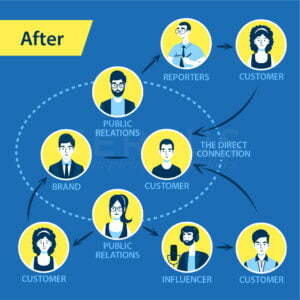Public relations as defined by Philip Kotler is an unpaid form of advertising, a part of your go-to-market strategy that creates a brand pull not by the organization blowing its own horn but by getting people/publication of repute to blow your horn.


Changing Dynamics of Public Relations
Traditional PR
Traditionally, PR was about connecting with key media influencers, opinion leaders, journalists. Engaging with them, educating them about the brand, its offerings, USP and differentiating factors, thereby influencing them to tell the brand story of its products in a way that was favourable for the brand/ offering & engaged the end customer. The job required making connections with a set media group, writing press releases, holding media events & interactions, and fighting for placement in prestigious publications for the brand.
Then came the digital revolution—often called the Fourth Revolution—which changed the way we communicate and connect. Suddenly, everyone with an opinion had an opportunity to voice it and seek out like-minded people. This changed the very definition of an influencer. These changes impacted PR, forcing it to adapt and change.
The New-Age PR
In this era of Tweet first, think later, everyone is a journalist and a newsmaker. Blogging and social media have made everyone a publisher.
These changed the PR scenario in two key ways: one, the universe of Influencers became dynamic and ever-growing. Influencers today need not be renowned media people, opinion leaders, or celebrities. They could be a blogger with a good following or a social media sensation—anyone who, with their content or talent, has engaged a large audience and has a direct connection with them. They have today become one of the most sought-after media for organizations to get their message out to their end customers.
Secondly, the news has become more personalized. The online AI, through your online interactions, learns your tastes and interests and serves you content aligned to your interests.
These changes have brought Content creation to the centre of the PR strategy. The focus is on the quality and variety of the messaging for maximum reach and impact.
Media monitoring to map company sentiment and competition has changed, too. No longer is it limited to print or broadcast media; it today encompasses the entire online universe—social media, Consumer forums, Employment sites, etc.
Public Relations morphed from a mode of making announcements and publishing new releases to storytelling.
A successful PR strategy today encompasses an integrated approach to communication where content rules.
The creativity that was once the advertising team’s prerogative is now an integral part of a PR campaign.
To create an impactful PR campaign, you need to humanize, be an empathetic storyteller, be local, merge data and human truth and create a product/service ambition.
The way organizations today are looking at Public Relations as a function, has changed too. From being a function to get media coverage, earned media and maintaining a public image, to one responsible for managing the Company’s Reputation. Organizations have realized the reputation management is more than just the outreach of your message and monitoring its reception.




